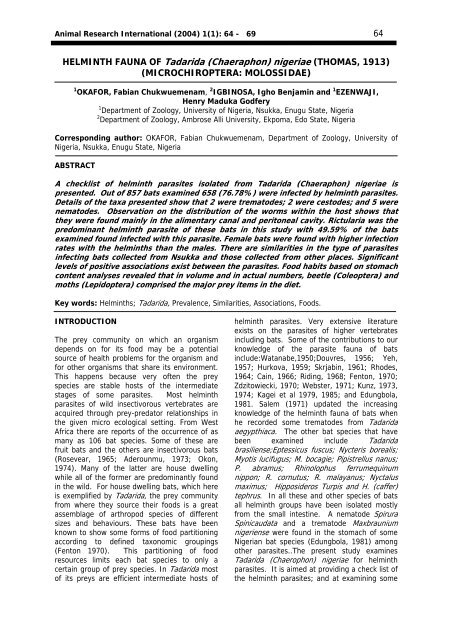Length-weight relationship of fishes from Anambra ... - Zoo-unn.org
Length-weight relationship of fishes from Anambra ... - Zoo-unn.org
Length-weight relationship of fishes from Anambra ... - Zoo-unn.org
- No tags were found...
You also want an ePaper? Increase the reach of your titles
YUMPU automatically turns print PDFs into web optimized ePapers that Google loves.
Animal Research International (2004) 1(1): 64 - 69 64HELMINTH FAUNA OF Tadarida (Chaeraphon) nigeriae (THOMAS, 1913)(MICROCHIROPTERA: MOLOSSIDAE)1 OKAFOR, Fabian Chukwuemenam, 2 IGBINOSA, Igho Benjamin and 1 EZENWAJI,Henry Maduka Godfery1 Department <strong>of</strong> <strong>Zoo</strong>logy, University <strong>of</strong> Nigeria, Nsukka, Enugu State, Nigeria2 Department <strong>of</strong> <strong>Zoo</strong>logy, Ambrose Alli University, Ekpoma, Edo State, NigeriaCorresponding author: OKAFOR, Fabian Chukwuemenam, Department <strong>of</strong> <strong>Zoo</strong>logy, University <strong>of</strong>Nigeria, Nsukka, Enugu State, NigeriaABSTRACTA checklist <strong>of</strong> helminth parasites isolated <strong>from</strong> Tadarida (Chaeraphon) nigeriae ispresented. Out <strong>of</strong> 857 bats examined 658 (76.78%) were infected by helminth parasites.Details <strong>of</strong> the taxa presented show that 2 were trematodes; 2 were cestodes; and 5 werenematodes. Observation on the distribution <strong>of</strong> the worms within the host shows thatthey were found mainly in the alimentary canal and peritoneal cavity. Rictularia was thepredominant helminth parasite <strong>of</strong> these bats in this study with 49.59% <strong>of</strong> the batsexamined found infected with this parasite. Female bats were found with higher infectionrates with the helminths than the males. There are similarities in the type <strong>of</strong> parasitesinfecting bats collected <strong>from</strong> Nsukka and those collected <strong>from</strong> other places. Significantlevels <strong>of</strong> positive associations exist between the parasites. Food habits based on stomachcontent analyses revealed that in volume and in actual numbers, beetle (Coleoptera) andmoths (Lepidoptera) comprised the major prey items in the diet.Key words: Helminths; Tadarida, Prevalence, Similarities, Associations, Foods.INTRODUCTIONThe prey community on which an <strong>org</strong>anismdepends on for its food may be a potentialsource <strong>of</strong> health problems for the <strong>org</strong>anism andfor other <strong>org</strong>anisms that share its environment.This happens because very <strong>of</strong>ten the preyspecies are stable hosts <strong>of</strong> the intermediatestages <strong>of</strong> some parasites. Most helminthparasites <strong>of</strong> wild insectivorous vertebrates areacquired through prey-predator <strong>relationship</strong>s inthe given micro ecological setting. From WestAfrica there are reports <strong>of</strong> the occurrence <strong>of</strong> asmany as 106 bat species. Some <strong>of</strong> these arefruit bats and the others are insectivorous bats(Rosevear, 1965; Aderounmu, 1973; Okon,1974). Many <strong>of</strong> the latter are house dwellingwhile all <strong>of</strong> the former are predominantly foundin the wild. For house dwelling bats, which hereis exemplified by Tadarida, the prey community<strong>from</strong> where they source their foods is a greatassemblage <strong>of</strong> arthropod species <strong>of</strong> differentsizes and behaviours. These bats have beenknown to show some forms <strong>of</strong> food partitioningaccording to defined taxonomic groupings(Fenton 1970). This partitioning <strong>of</strong> foodresources limits each bat species to only acertain group <strong>of</strong> prey species. In Tadarida most<strong>of</strong> its preys are efficient intermediate hosts <strong>of</strong>helminth parasites. Very extensive literatureexists on the parasites <strong>of</strong> higher vertebratesincluding bats. Some <strong>of</strong> the contributions to ourknowledge <strong>of</strong> the parasite fauna <strong>of</strong> batsinclude:Watanabe,1950;Douvres, 1956; Yeh,1957; Hurkova, 1959; Skrjabin, 1961; Rhodes,1964; Cain, 1966; Riding, 1968; Fenton, 1970;Zdzitowiecki, 1970; Webster, 1971; Kunz, 1973,1974; Kagei et al 1979, 1985; and Edungbola,1981. Salem (1971) updated the increasingknowledge <strong>of</strong> the helminth fauna <strong>of</strong> bats whenhe recorded some trematodes <strong>from</strong> Tadaridaaegypthiaca. The other bat species that havebeen examined include Tadaridabrasiliense;Eptessicus fuscus; Nycteris borealis;Myotis lucifugus; M. bocagie; Pipistrellus nanus;P. abramus; Rhinolophus ferrumequinumnippon; R. cornutus; R. malayanus; Nyctalusmaximus; Hipposideros Turpis and H. (caffer)tephrus. In all these and other species <strong>of</strong> batsall helminth groups have been isolated mostly<strong>from</strong> the small intestine. A nematode SpiruraSpinicaudata and a trematode Maxbrauniumnigeriense were found in the stomach <strong>of</strong> someNigerian bat species (Edungbola, 1981) amongother parasites..The present study examinesTadarida (Chaerophon) nigeriae for helminthparasites. It is aimed at providing a check list <strong>of</strong>the helminth parasites; and at examining some

















